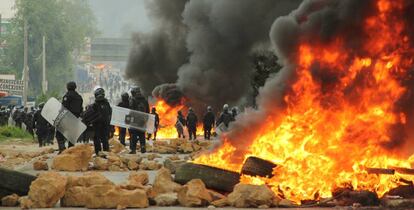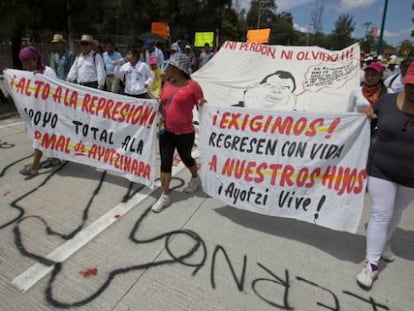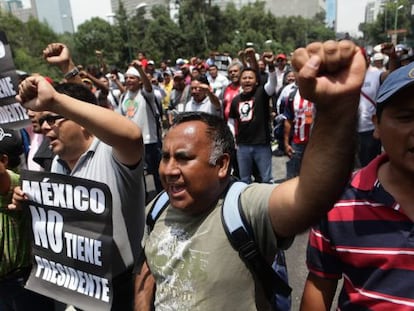Oaxaca tourism sector loses millions due to teachers’ strike
State business association says the area is grappling with a shortage in basic goods while the black market is growing

At the height of the vacation season, Oaxaca is no longer a tourist destination. A teachers’ strike against education reforms has led to a 30% increase in hotel cancellations, the state’s business association says. The trend is growing even as Guelaguetza, a popular indigenous festival, approaches. That sharp decline in tourist visits will lead to a massive loss for the industry that hoped to make 300 million pesos in two weeks.
“The tourism sector loses 1.7 million every day in Oaxaca capital alone,” says Benjamín Hernández, president of Oaxaca’s business association. After violent clashes between demonstrators and police on June 19 led to nine civilian deaths, tourists have lost trust in Oaxaca. The situation, which has been tense for a month, has caused some hotels to close for the whole of July. “On Wednesday a hotel in the historic quarter of the capital closed because it only had 13 booked rooms for July when it is usually full by now.”
The situation, which has been tense for a month, has caused some hotels to close for the whole of July
Hernández warns against the negative impact the decline in tourism at the peak of the season could have on one of the poorest regions in the country. Guelaguetza is usually when the industry makes the most money. A 30% cancellation rate in hotel reservations means a 75-million-peso loss. “But that number continues to grow. There are cancellations every day,” Hernández says.
Teachers from the National Coordinator of Education Workers (CNTE) have maintained roadblocks along the most important streets even after that pitched battle with the police on June 19. “Trucks only circulate on the strategic roadways that they decide and foodstuffs arrive bit by bit,” Hernández says. Shortages in the cities have caused a surge in business on the black market and a sharp rise in prices. Businesses say prices have gone up by as much as 300% in some cases. A liter of gasoline costs 40 pesos ($2) in Oaxaca and 13.16 pesos in the rest of the country.
Sales have dropped by 85%, some businesses say. Companies have even stopped shipping goods to Oaxaca because of the risk the situation poses to their vehicles and employees. “The trucks that manage to arrive may take up to 30 hours, if they manage it. It’s not profitable for them,” Hernández explains.
Companies have even stopped shipping goods to Oaxaca because of the risk the situation poses to their vehicles and employees
The areas most affected by the shortages are the capital and the localities along the coast and the Isthmus of Tehuantepec in the south. Mexico’s Ministry of Social Development (SEDESOL) said on Wednesday that it will deliver basic foods to those areas by plane. “We are living in a state of defenselessness,” Hernández adds. The lack of products goes from basic foods to a shortage in cash at ATMs, businesses say.
The association is asking the federal government to declare Oaxaca “an economic disaster zone” and is demanding a review of damages caused by the teachers’ strike in order to determine how much it would take to repair the situation.
English version by Dyane Jean François.
Sign up to our newsletter
EL PAÍS English Edition has launched a weekly newsletter. Sign up today to receive a selection of our best stories in your inbox every Saturday morning. For full details about how to subscribe, click here.
Tu suscripción se está usando en otro dispositivo
¿Quieres añadir otro usuario a tu suscripción?
Si continúas leyendo en este dispositivo, no se podrá leer en el otro.
FlechaTu suscripción se está usando en otro dispositivo y solo puedes acceder a EL PAÍS desde un dispositivo a la vez.
Si quieres compartir tu cuenta, cambia tu suscripción a la modalidad Premium, así podrás añadir otro usuario. Cada uno accederá con su propia cuenta de email, lo que os permitirá personalizar vuestra experiencia en EL PAÍS.
¿Tienes una suscripción de empresa? Accede aquí para contratar más cuentas.
En el caso de no saber quién está usando tu cuenta, te recomendamos cambiar tu contraseña aquí.
Si decides continuar compartiendo tu cuenta, este mensaje se mostrará en tu dispositivo y en el de la otra persona que está usando tu cuenta de forma indefinida, afectando a tu experiencia de lectura. Puedes consultar aquí los términos y condiciones de la suscripción digital.











































